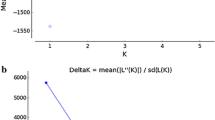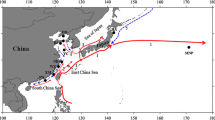Abstract
The genetic diversity of wild and hatchery-released Pacific herring Clupea pallasii collected from three brackish lakes and two bays in Honshu and Hokkaido, Japan was examined with five microsatellite loci. All loci showed high genetic variability with expected heterozygosities ranging from 0.815 to 0.945. Significant differences in genotypic and allelic distributions were detected among all locations except for between the two bays in Honshu Island. Pairwise population analysis based on the F ST > values showed close genetic relationships among the locations in Hokkaido Island, and the hierarchical analyses of molecular variance showed significant genetic difference between the two islands. Those results suggest the existence of subpopulations due to natal homing. In addition, stocked fish showed as much genetic diversity as the wild fish. The pairwise population analyses also showed close relationships between the hatchery fish and the wild fish in respective stocking areas, showing that no effects of stocking programs on genetic diversity of wild populations were detected.
Similar content being viewed by others
References
Levin SA, Grenfell B, Hastings A, Perelson AS. Mathematical and computational challenges in population biology and ecosystem science. Science 1997; 275: 334–343.
Hanski I. Metapopulation dynamics. Nature 1998; 396: 41–49.
Slatkin M. Gene flow and the geographic structure of natural populations. Science 1987; 236: 787–792.
Endler JA. Genetic heterogeneity and ecology. In: Berry RJ, Crawford TJ, Hewitt GM (eds). Genes in Ecology. Blackwell Scientific Publications, Oxford. 1991; 315–334.
Waples RS. Pacific Salmon, Oncorhynchus spp. and the definition of ‘Species’ under the Endangered Species Act. Mar. Fish. Rev. 1991; 53: 11–22.
Waples RS. Evolutionarily significant units and the conservation of biological diversity under the Endangered Species Act. In: Nielsen JL, Powers GA (eds). Evolution and the Aquatic Ecosystem: Defining Unique Units in Population Conservation, American Fisheries Society Symposium Vol. 17. American Fisheries Society, Bethesda, MD. 1995, 8–27.
Smedbol KR, Wroblewski JS. Metapopulation theory and northern cod population structure: interdependency of subpopulations in recovery of a groundfish population. Fish. Res. 2002; 55: 161–174.
FAO Fisheries Department. Report of the expert consultation on utilization and conservation of aquatic genetic resources. FAO Fish. Rep. 1993; 491: 1–58.
Utter F. Population genetics, conservation and evolution in salmonids and other widely cultured fishes: some perspective over six decades. Rev. Fish Biol. Fish. 2004; 14: 125–144.
Campton DE. Genetic effects of hatchery fish on wild populations of Pacific salmon and steelhead: what do we really know? In: Schramm HL, Piper RG (eds). Uses and Effects of Cultured Fishes in Aquatic Ecosystems, American Fisheries Society Symposium, Vol. 15. American Fisheries Society, Bethesda. 1995; 337–353.
Svetovidov AN. Clupeidae. In: Fauna of U.S.S.R. Fishes Vol. 2, No. 1 (Translated from Fauna of U.S.S.R. Acad. Nauk. SSSR Zool Inst. N. S. 48 in Russian) Israel Program Sci. Tansl., Jerusalem. 1963; 120–179.
Hart JL. Pacific fishes of Canada. Fish. Res. Board Can. Bull. 1973; 180: 730.
Kobayashi T, Yabuki K, Sasaki M, Kodama J. Long-term fluctuation of the catch of Pacific herring in Northern Japan. In: Megrey BA, Taft BA, Peterson WT (eds). Pices-Globec International Program on Climate Change and Carrying Capacity: Report of the 1999 Monitor and Rex Workshops, and the 2000 Model Workshop on Lower Trophic Level Modelling, PICES Scientific Report No. 15. PICES, Sidney. 2000; 103–106.
Kobayashi T. History of herring fishery in Hokkaido and the review of population study (Review). Sci. Rep. Hokkaido Fish. Exp. Stn. 2002; 62: 1–8.
Kanno Y. Variations in meristic and morphometric characters among populations of herring Clupea pallasii in the far eastern waters. Nippon Suisan Gakkaishi 1989; 55: 431–439.
Kanno Y. Comparison of age composition, sex ratio and growth rate among populations of herring Clupea pallasii in the far eastern waters. Nippon Suisan Gakkaishi 1989; 55: 583–589.
Kobayashi T, Iwata M, Numachi K. Genetic divergence among local spawning populations of pacific herring in the vicinity of northern Japan. Nippon Suisan Gakkaishi 1990; 56: 1045–1052.
Yamamoto Y. Seedling Production Techniques of Pacific Herrings, Technical Series 7. JASFA, Tokyo, 2000 (in Japanese).
Fishery Agency Fisheries Research Agency and National Abundantly Productive Sea Promotion Association (ed.). Annual Statistics of Seed Production and Release in 1998–2005. National Abundantly Productive Sea Promote Association. Tokyo. 2000–2007 (in Japanese).
O’Connell M, Dillon MC, Wright JM, Bentzen P, Merkouris S, Seeb J. Genetic structuring among Alaskan Pacific herring populations identified using microsatellite variation. J. Fish Biol. 1998; 53: 150–163.
Small MP, Loxterman JL, Frye AE, Bargen JFV, Bowman C, Young SF. Temporal and spatial genetic structure among some Pacific herring populations in Puget Sound and the southern strait of Georgia. Trans. Am. Fish. Soc. 2005; 134: 1329–1341.
McPherson AA, Stephenson RL, O’Reilly PT, Jones MW, Taggart CT. Genetic diversity of coastal northwest Atlantic herring populations: implications for management. J. Fish Biol. 2001; 59: 356–370.
McPherson AA, Stephenson RL, Taggart CT. Genetically different Atlantic herring Clupea harengus spawning waves. Mar. Ecol. Prog. Ser. 2003; 247: 303–309.
Jørgensen HBH, Hansen MM, Loeschcke V. Spring-spawning herring (Clupea harengus L.) in the southwestern Baltic Sea: do they form genetically distinct spawning waves? ICES J. Mar. Sci. 2005; 62: 1065–1075.
Okouchi H. Stocking effectiveness assessment and making techniques in marine stock enhancement. Nippon Suisan Gakkaishi 2006; 72: 450–453 (in Japanese).
Takagi M, Taniguchi N, Cook D, Doyle RW. Isolation and characterization of microsatellite loci from red sea bream Pagrus major and detection in closely related species. Fish. Sci. 1997; 63: 199–204.
O’Connell M, Dillon MC, Wright JM. Development of primers for polymorphic microsatellite loci in the Pacific herring (Clupea harengus pallasi). Mol. Ecol. 1998; 7: 357–363.
Van Oosterhout C, William F, Hutchinson DP, Wills M, Shipley P. Micro-Checker: software for identifying and correcting genotyping errors in microsatellite data. Mol. Ecol. Notes 2004; 4: 535–538.
Nei M. Molecular Evolutionary Genetics. Columbia University Press, New York. 1987.
El Mousadik A, Petit AJ. High level of genetic differentiation for allelic richness among populations of the argan tree [Argania spinosa (L.) Skeels] endemic to Morocco. Theor. Appl. Genet. 1996; 92: 832–839.
Sokal RR, Rohlf FJ. Nonparametric methods in Lieu of single-classification Anova. In: BIOMETRY: The Principles and Practice of Statistics in Biological Research, 3rd edn. Freeman and Co., New York. 1995; 423–439.
Steel RGD. A rank sum test for comparing all pairs of treatments. Technometrics 1960; 2: 197–207.
Dwass M. Some k-sample rank-order tests. In: Olkin I, Ghurye SG, Hoeffding H, Madow WG, Mann HB (eds). Contributions to Probability and Statistics. Stanford University Press, Stanford, CA. 1960; 198–202.
Raymond M, Rousset F. GENEPOP (ver. 3.4): population genetics software for exact tests and ecumenicism. J. Hered. 1995; 86: 248–249.
Raymond M, Rousset F. An exact test for population differentiation. Evolution 1995; 49: 1280–1283.
Schneider S, Roessli D, Excoffier L. Arlequin, Ver. 2.000: A Software for Population Genetic Data Analysis. Genetics and Biometry Laboratory, University of Geneva, Geneva. 2000.
Hardy OJ, Vekemans X. SPAGeDi: a versatile computer program to analyse spatial genetic structure at the individual or population levels. Mol. Ecol. Notes 2002; 2: 618–620.
Rice RW. Analyzing tables of statistical tests. Evolution 1989; 43: 223–225.
Young FW, Takane Y, Lewyckyj R. ALSCAL: a multidimensional scaling package with several individual differences options. Am. Stat. 1980; 34: 117–118.
Takane Y, Young F, Leeuw JD. Non-metric individual differences multidimensional scaling: an alternating least squares method with optimal scaling features. Psychometrika 1976; 42: 7–67.
Excoffier L, Smouse PE, Quattro JM. Analysis of molecular variance inferred from metric distances among DNA haplotypes: application to human mitochondrial DNA restriction data. Genetics 1992; 131: 479–491.
Okouchi H, Kodama J, Nagashima H, Kabutomori Y, Iwamoto A. Migration and natal homing of Pacific herring along the Pacific coast of Honshu Islands. Report of the Fish Resource Investigation for Stock Enhancement No. 16. Japan Sea Farming Association, Tokyo. 2003 (in Japanese).
Aomori Prefecture. Red Data Book Aomori. Aomori Prefecture, Aomori. 2000 (in Japanese).
Kanno Y. Ecology and stock structure of the Pacific herring (Clupea pallasii) in Japan. Saibai Giken 1983; 12: 59–69 (in Japanese).
McQuinn IH. Metapopulation and the Atlantic herring. Rev. Fish Biol. Fish. 1997; 7: 297–329.
Ryman N, Laikre L. Effects of supportive breeding on the genetically effective population size. Conserv. Biol. 1991; 5: 325–329.
Author information
Authors and Affiliations
Corresponding author
Rights and permissions
About this article
Cite this article
Sugaya, T., Sato, M., Yokoyama, E. et al. Population genetic structure and variability of Pacific herring Clupea pallasii in the stocking area along the Pacific coast of northern Japan. Fish Sci 74, 579–588 (2008). https://doi.org/10.1111/j.1444-2906.2008.01561.x
Received:
Accepted:
Issue Date:
DOI: https://doi.org/10.1111/j.1444-2906.2008.01561.x




